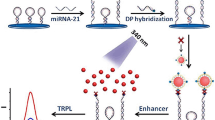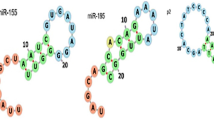Abstract
The authors report on a new approach for the determination of the breast cancer biomarker microRNA-155 (miRNA-155). It is based on the measurement of the fluorescence shift of oligonucleotide-templated copper nanoclusters (DNA-CuNC). A probe DNA was designed that acts as a template for the preparation of CuNC which, under 400 nm excitation, exhibit strong fluorescence enhancement at 490 nm and a 90 nm Stokes shift after binding to target miRNA-155 and formation of a DNA-RNA heteroduplex. Under the optimal conditions, the fluorescence of the DNA-CuNC increases with increasing concentration of miRNA-155 in the range from 50 pM to 10 nM, with a 11 pM detection limit. The assay has excellent selectivity over noncomplementary RNA. The method was applied to the determination of miRNA-155 in the presence of human plasma and saliva.

Schematic of the detection strategy that relies on the fluorescence shift of DNA-CuNCs resulting from the specific binding of DNA-CuNCs with target miRNA-155. Fluorescence intensities are linearly proportional to the concentrations of target RNA from 50 pM to 10 nM.






Similar content being viewed by others
References
Zhu J, Zheng Z, Wang J, Sun J, Wang P, Cheng X, Fu L, Zhang L, Wang Z, Li Z (2014) Different miRNA expression profiles between human breast cancer tumors and serum. Front Genet 149. doi:10.3389/fgene.2014.00149
Zhang GJ, Chua JH, Chee RE, Agarwal A, Wong SM (2009) Label-free direct detection of MiRNAs with silicon nanowire biosensors. Biosens Bioelectron 24:2504–2508
Yang WJ, Li XB, Li YY, Zhao LF, He WL, Gao YQ, Wan YJ, Xia W, Chen T, Zheng H, Li M, Xu SQ (2008) Quantification of microRNA by gold nanoparticle probes. Anal Biochem 376:183–188
Zhao SY, Wu Q, Gao F, Zhang CB, Yang XW (2012) Increased expression of MicroRNA-155 in the serum of women with early-stage breast cancer. Science 43:177–180
Wu X, Chai Y, Yuan R, Zhuo Y, Chen Y (2014) Dual signal amplification strategy for enzyme-free electrochemical detection of microRNAs. Sensors Actuators B Chem 203:296–302
Schooneveld EV, Wildiers H, Vergote I, Vermeulen PB, Dirix LY, Van Laere SJ (2015) Dysregulation of microRNAs in breast cancer and their potential role as prognostic and predictive biomarkers in patient management. Breast Cancer Res 17:21
McGuire A, Brown JAL, Kerin MJ (2015) Metastatic breast cancer: the potential of miRNA for diagnosis and treatment monitoring. Cancer Metastasis Rev 34:145–155
Gurses HE, Hatipoglu OF, Gunduz M, Gunduz E (2015) MicroRNAs as therapeutic targets in human breast cancer. In: Gunduz M (ed) A concise review of molecular pathology of breast cancer, Chapter 5. InTech, Croatia, pp. 121–137
V’al’oczi A, Hornyik C, Varga N, Burgy’an J, Kauppinen S, Havelda Z (2004) Sensitive and specific detection of microRNAs by northern blot analysis using LNA-modified oligonucleotide probes. Nucleic Acids Res 32:e175
Li W, Ruan KC (2009) MicroRNA detection by microarray. Anal Bioanal Chem 394:1117–1124
Sempere LF, Dubrovsky EB, Dubrovskaya VA, Berger EM, Ambros V, Ros A (2002) The expression of the let-7 small regulatory RNA is controlled by ecdysone during metamorphosis in Drosophila melanogaster. Dev Biol 244:170–179
Kroh EM, Parkin RK, Mitchell PS, Tewari M (2010) Analysis ofcirculating microRNA biomarkers in plasma and serum using quantitative reverse transcription-PCR (qRT-PCR). Methods 50:298–301
Maroney PA, Chamnongpol S, Souret F, Nilsen TW (2008) Directdetection of small RNAs using splinted ligation. Nat Protocols 3:279–287
Lua Y, Chen W (2012) Sub-nanometre sized metal clusters: from synthetic challenges to the unique property discoveries. Chem Soc Rev 41:3594–3623
Jia X, Li J, Wang E (2013) Cu nanoclusters with aggregation induced emission enhancement. Small 9:3873–3879
Sharma J, Yeh HC, Yoo H, Werner JH, Martinez JS (2011) Silver nanocluster aptamers: in situ generation of intrinsically fluorescent recognition ligands for protein detection. Chem Commun 47:2294–2296
Liu L, Yang Q, Lei J, Xua N, Ju H (2014) DNA-regulated silver nanoclusters for label-free ratiometric fluorescence detection of DNA. Chem Commun 50:13698–13701
Huang Y, Lein J, Cheng Y, Ju H (2016) Ratiometric electrochemiluminescent strategy regulated by electrocatalysis of palladium nanocluster for immunosensing. Biosens Bioelectron 77:733–739
Borghei YS, Hosseini M, Dadmehr M, Hosseinkhani S, Ganjali MR, Sheikhnejad R (2016) Visual detection of cancer cells by colorimetric aptasensor based on aggregation of gold nanoparticle induced by DNA hybridiztion. Anal Chim Acta 904:92–97
Dadmehr M, Hosseini M, Hosseinkhani S, Ganjali MR, Sheikhnejad R (2015) Label free colorimetric and fluorimetric direct detection of methylated DNA based on silver nanoclusters for cancer early diagnosis. Biosens Bioelectron 73:108–113
Ahmadzadeh KH, Hosseini M, Dadmehr M, Ganjali MR (2016) Rapid restriction enzyme free detection of DNA Methytransferase activity based on DNA-templated siver nanoclusters. Anal Bioanal Chem 408:4311–4318
Kumar Das N, Ghosh S, Priya A, Datta S, Mukherjee S (2015) Luminescent copper nanoclusters as a specific cell-imaging probe and a selective metal ion sensor. J Phys Chem C 119:24657–24664
Wang C, Yao Y, Song Q (2016) Interfacial synthesis of polyethyleneimine-protected coppernanoclusters: size-dependent tunable photoluminescence, pH sensorand bioimaging. Colloid Surfaces B 140:373–381
Cui M, Song G, Wang C, Song Q (2015) Synthesis of cysteine-functionalized water-soluble luminescent copper nanousters and their application to the determination of chromium(VI). Microchem Acta 182:1371–1377
Cathcart N, Mistry P, Makra C, Pietrobon B, Coombs N, Jelokhani-Niaraki M, Kitaev V (2009) Chiral thiol-stabilized silver nanoclusters with well-resolved optical transitions synthesized by a facile etching procedure in aqueous solutions. Langmuir 25:5840–5846
Yang X, Feng Y, Zhu S, Luo Y, Zhuo Y, Dou Y (2014) One-step synthesis and applications of fluorescent cu nanoclusters stabilized by L-cysteine in aqueous solution. Anal Chim Acta 847:49–54
Mao Z, Qing Z, Qing T, Xu F, Wen L, He X, He D, Shi H, Wang K (2015) Poly(thymine)-templated copper nanoparticles as a fluorescent indicator for hydrogen peroxide and oxidase-based Biosensing. Anal Chem 87:7454–7460
Liu G, Shao Y, Peng J, Dai W, Liu L, Xu S, Wu F, Wu X (2013) Highly thymine-dependent formation of fluorescent copper nanoparticles templated by ss-DNA. Nanotechnology 24:345502 (7pp)
Qing Z, Mao Z, Qing T, He X, Zou Z, He D, Shi H, Huang J, Liu J, Wang K (2014) Visual and portable strategy for copper(II) detection based on a strip like poly(thymine)-caged and Microwell-printed hydrogel. Anal Chem 86:11263–11268
Hu Y, Wu Y, Chen T, Chu X, Yu R (2013) Double-strand DNA-templated synthesis of copper nanoclusters as novel fluorescence probe for label-free detection of biothiols. Anal Methods 5:3577–3613
Liu J, Zhang QM, Feng Y, Zhou Z, Shih K (2016) Solvent-switching gelation and Orange–red emission of Ultrasmall copper nanoclusters. ChemPhysChem 17:225–231
Knowles KE, Hartstein KH, Kilburn TB, Marchioro A, Nelson HD, Whitham PJ, Gamelin DR (2016) Luminescent colloidal semiconductor nanocrystals containing copper: synthesis, Photophysics, and applications. Chem Rev 116:10820–10851
Yuan X, Tay Y, Dou X, Luo Z, Leong DT, Xie J (2013) Glutathione-protected silver nanoclusters as cysteine-selective Fluorometric and colorimetric probe. Anal Chem 85:1913–1919
Chai F, Wang C, Wang T, Ma Z, Su Z (2010) L-cysteine functionalized gold nanoparticles for the colorimetric detection of Hg2+ induced by ultraviolet light. Nanotechnology 21:025501 (6pp)
Cui M, Song G, Wang C, Song Q (2015) Synthesis of cysteine-functionalized water –soluble luminescent copper nanoclusters and their application to the determination of chromium. Microchim Acta 182:1371–1377
Tyagi S, Marras SAE, Kramer FR (2000) Wavelength-shifting molecular beacons. Nat Biotech 18:1191–1196
Lee SY, Hairul Bahara NH, Choon g YS, Lim TS, Tye GJ (2014) DNA fluorescence shift sensor: a rapid method for the detection of DNA hybridization using silver nanoclusters. J Colloid Interface Sci 433:183–188
Jia X, Li J, Han L, Ren J, Yang X, Wang E (2012) DNA-hosted copper nanoclusters for fluorescent identification of single nucleotide polymorphisms. ACS Nano 4:3311–3317
Shi H-Y, Yang L, Zhou X-Y, Bai J, Gao J, Jia H-X, Li Q-G (2017) A gold nanoparticle-based colorimetric strategy coupled to duplex-specific nuclease signal amplification for the determination of microRNA. Microchim Acta 184(2):525–531
Chi BZ, Liang RP, Qiu WB, Yuan YH, Qiu JD (2017) Direct fluorescence detection of microRNA based on enzymatically engineered primer extension poly-thymine (EPEPT) reaction using copper nanoparticles as nano-dye. Biosens Bioelectron 87:216–221
Guo Y, Wang Y, Yang G, Xu J-J, Chen H-Y (2016) MicroRNA-mediated signal amplification coupled with GNP/ dendrimers on a mass-sensitive biosensor and its applications in intracellular microRNA quantification. Biosens Bioelectron 85:897–902
Feng Q-M, Shen Y-Z, Li M-X, Zhang Z-L, Zhao W, Xu J-J, Chen H-Y (2016) Dual-wavelength electrochemiluminescence ratiometry based on resonance energy transfer between au nanoparticles functionalized g-C3N4 nanosheet and Ru(bpy)3 2+ for microRNA detection. Anal Chem 88(16):8179–8187
Wu Y, Han J, Xue P, Xu R, Kang Y (2015) Nano metal-organic framework (NMOF)-based strategies for multiplexed MicroRNA detection in solution and living cancer cells. Nano 7:1753–1759
Liu H, Bei X, Xia Q, Fu Y, Zhang S, Liu M, Fan K, Zhang M, Yang Y (2015) Enzyme-free electrochemical detection of microRNA-21 using immobilized hairpin probes and a target-triggered hybridization chain reaction amplification strategy. Microchim Acta 183:297–304
Yang J, Tang M, Diao W, Cheng W, Zhang Y, Yan Y (2016) Electrochemical strategy for ultrasensitive detection of microRNA based on MNAzyme-mediated rolling circle amplification on a gold electrode. Microchim Acta 183:3061–3068
Acknowledgements
The authors thank the research Council of University of Tehran for financial support of this work.
Author information
Authors and Affiliations
Corresponding author
Ethics declarations
The author(s) declare that they have no competing interests.
Electronic supplementary material
ESM 1
(DOC 1174 kb)
Rights and permissions
About this article
Cite this article
Borghei, YS., Hosseini, M. & Ganjali, M.R. Fluorescence based turn-on strategy for determination of microRNA-155 using DNA-templated copper nanoclusters. Microchim Acta 184, 2671–2677 (2017). https://doi.org/10.1007/s00604-017-2272-6
Received:
Accepted:
Published:
Issue Date:
DOI: https://doi.org/10.1007/s00604-017-2272-6




